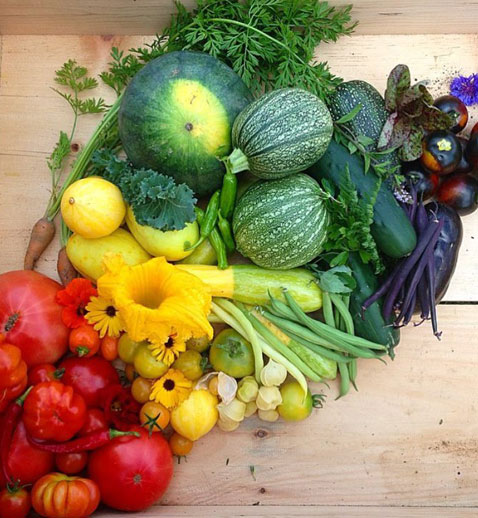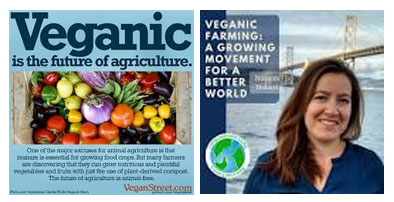Vegan International participates in achieving FAO’s strategic objectives of eliminating hunger, food insecurity and malnutrition by promoting the vegan diet which uses far less resources of land and water than the conventional diet. Vegan International participates in making agriculture more productive and sustainable by promoting veganic farming which uses no animal inputs or the unsustainable, wasteful use of resources, such as land and water, as used for the meat and dairy based diet.
Veganic farming uses no fertilizer, it relies on ‘green manure’, nitrogen rich crops which are not harvested, but plowed under to provide nutrients which crops for food require. Harmful pesticides are not needed because veganic farming uses crop rotation, unlike organic farming which, like conventional farming, relies on harmful pesticides.
A veganic farm is a form of sustainable agriculture which uses no animal inputs for soil fertility. Instead it uses green manures. This is a method of farming which employs crop rotations, cover crops, veganic compost, and imaginative and creative uses of green manures. Some are plowed under, some are killed and left on the surface of the soil for crops to be planted into, and some are planted between rows. Different green manures offer different benefits to the soil. Soil fertility is key to nutritious food since crops take their nutritional value from the soil. Tasteless fruits and vegetables indicate that they have been grown in depleted soil. Soil that is depleted cannot product crops that have vitamins, minerals, and taste. All elements found on the Periodic Chart of the Elements are needed for the human body. All except a few are found in soil. The other few are in the air. You cannot have good Minerals such as lime and phosphorous are added to amend the soil. Veganic farming uses no manure, blood, or bone meal from factory farms and slaughterhouses as is typically used in organic farming. Pests are managed first through crop rotation. Then the philosophy, “Know your Enemy”, involves diagnosing the pest or disease. Its life cycle is analyzed to find the vulnerable point. Next the philosophy, “My Enemy’s Enemy is my Friend”, is employed, and a predator is found that can control situation at that vulnerable point. This eliminates the need for toxic pesticides, even the “natural” poisons used in organic farming. Veganic farming relies on the use of harmless soaps and ashes for pest control.
The end result of veganic farming is produce that is loaded with vitamins and minerals, and has no toxic or poisonous pesticides, no hormones or antibiotics from animal manures and inputs as used in conventional and organic farming, has a light carbon footprint, is globally sustainable, and is totally cruelty free.
Backed by Joe Fisher, John Schoeppner, RyanEmily, Green Mountain Animal Defenders, Mark Epstein, Jimbo Janwarwala, Richard Cianci, Anthony Luciano, Gene Baur, Joanne Bowley, Green Mountain Veggies, Evan Sebastian, Chloe Elizabeth, Kathleen Serafin, John Patrick Hayden, Adam Cooperstein, Stephanie Lucas, Zach Stednick, Melis Ökter, Elizabeth Fagenholz, Kelly MacIntyre, Anna Lab, Shailo Layong Mist, Varinder Singh Bal, Isabella La Rocca, and Carole Lovesey
Industrial chemical-based agriculture is one of the most destructive human activities on the planet, linked to harmful effects on biodiversity, environmental quality, and farmworker health. Alternative agricultural paradigms avoid chemical inputs yet often rely on animal byproducts sourced from industrial agriculture, such as blood meal and manure. These byproducts are tied to a spectrum of issues, such as potential environmental contamination from veterinary pharmaceuticals and the presence of animal pathogens transmittable to consumers (e.g, E. coli). How do we avoid these problems and grow healthy vegetables, grains, and other plant foods that do not financially or symbolically support industrial agriculture and animal exploitation? Veganic agriculture represents a way forward.As the ethical, environmental, and personal health arguments for plant-based diets become increasingly recognized, the demand for food produced without animal inputs is expected to rise. In addition to offering truly plant-based food options to vegans, veganic agriculture has the potential to provide regenerative and agroecological solutions to leading food system issues, including resource depletion, environmental destruction, and foodborne illness related to animal by products. (Read More)

The word “Permaculture” was coined in 1978 by Bill Mollison, an Australian ecologist, and one of his students, David Holmgren. It is a contraction of “permanent agriculture” or “permanent culture.”
Permaculture is about designing ecological human habitats and food production systems. It is a land use and community building movement which strives for the harmonious integration of human dwellings, microclimate, annual and perennial plants, animals, soils, and water into stable, productive communities. The focus is not on these elements themselves, but rather on the relationships created among them by the way we place them in the landscape. This synergy is further enhanced by mimicking patterns found in Nature.
A central theme in Permaculture is the design of ecological landscapes that produce food. Emphasis is placed on multi-use plants, cultural practices such as sheet mulching and trellising, and the integration of animals to recycle nutrients and graze weeds. Permaculture is about Redundancy, you must have multiple functions for each element in your design, and all functions are supported by multiple elements. A tree provides summer shade, fruit for food, and habitat for birds. It also builds the soil by fixing nitrogen, thus enabling plants around it to grow.
However, Permaculture entails much more than just food production. Energy-efficient buildings, waste water treatment, recycling, and land stewardship in general are other important components of Permaculture. More recently, Permaculture has expanded its purview to include economic and social structures that support the evolution and development of more permanent communities, such as co-housing projects and eco-villages. As such, Permaculture design concepts are applicable to urban as well as rural settings, and are appropriate for single households as well as whole farms and villages.
